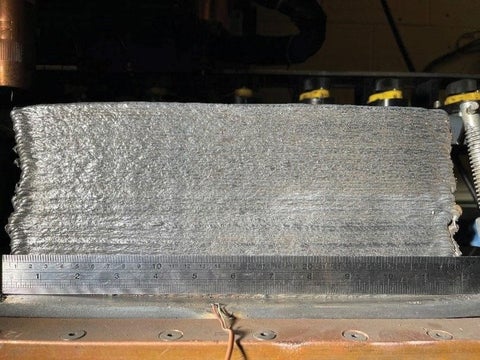
CAMJ Research Featured in Canadian Fabricating & Welding
From the webpage of Canadian Fabricating & Welding:
The automotive industry has been a catalyst for welding research in a variety of areas, including the joining of high strength steels and mixed metal joining. Some new research by the University of Waterloo in conjunction with Liburdi should assist some automotive applications, but also stainless steel pipe welding and wire arc additive manufacturing processes.
Controlling the Arc
“The work we have done with Liburdi is geared to developing a more consistent and more capable form of arc welding control,” said Adrian Gerlich, professor in the department of mechanical and mechatronics engineering, Waterloo, and part of the Waterloo Centre for Automotive Research. Gerlich and his team of research associates, which include Emanuel dos Santos and Paulo Costa Assuncao, have optimized a set of arc control parameters. “Basically, it is an improved pulse material transfer mode for arc welding of sensitive materials.”
Liburdi calls its controlled short-circuit metal transfer process the “dip transfer” process. What makes the process unique is the low heat input it yields.
“The heat input is 0.1 kJ per millimeter,” said Gerlich. “In high-strength steel applications, which are key for the automotive industry, we can get extremely uniform fillet deposition with such a low heat input that distortion will be minimized, which means less damage and degradation to the surrounding steel. Observing the microstructures, you see exactly what you would expect from a typical arc weld. But the heat input is about half that of most other advanced short-circuit metal transfer processes.”
The side benefit of this low heat transfer process is very low spatter.
“Droplets are being deposited a few hundred times per second, and you observe next to no spatter, no metal being ejected in that process,” said Gerlich. “It means a much cleaner finish.”
The low heat input is near the range of laser welding, according to Gerlich.
“Lasers tend to achieve a heat input between 0.05 kJ and 0.15 kJ per millimeter on these steels, so it is right in that wheelhouse,” he said. “The benefit of arc welding, of course, is that you don’t have the same requirements for safety enclosures, part fit-up, and tolerances are higher in laser welding, along with much lower cost.”
Pipe Applications
Although valuable in automotive applications, Gerlich sees this very low heat transfer process having the most immediate impact in the welding of stainless steel pipe.
“Where you have industrial challenges is that when you are arc welding thicker materials, such as in piping (¼ in. to 1 in.), a stainless steel weld will generally require an internal purge gas,” said Gerlich. “You have to internally cap the ends of the pipe and purge the interior volume with argon shielding gas to prevent it from oxidizing and heat tinting on the inside root of the weld.
“The interesting thing about this arc welding mode that we’ve developed is that it gives such a low heat input that it doesn’t heat tint the inside of the pipe, even without a backing gas. For anyone who has to do this type of welding, that represents an astronomical cost savings. Once you have to purge with shielding gas, you require additional certifications to handle cylinders, you have the additional cost of the argon, additional safety regulations such as permits for working in confined spaces when the pipes are being installed on a complex module. All of these things contribute to the cost of your project.”
Additive Advantages
The other application researchers at Waterloo have examined for this low heat deposition process is wire arc additive manufacturing in steel. Researchers conducted a study and were able to achieve a 12-in.-long, 6-in.-tall, and 4-mm-thick wall structure. Using a water-cooled torch, researchers also were able to achieve a higher hardness base and greater tensile strength than with naturally cooled metal.
“With wire arc additive, the advantage with low heat input is less distortion, less potential for cracking, and other potential imperfections,” said Gerlich. “It allows you to bridge the capabilities of ultra-high-precision powder bed fusion machines and conventional casting and machining. Of course, you don’t get the geometrical accuracy achieved in a powder bed because you have to deposit at least 4-mm wall thickness, but we are looking at applications where you are building components between 1 ft. to many metres in size, builds that replace castings. Large stainless steel castings, for instance, can be very expensive and require long lead times. It may take days to build such a part using wire arc additive, but it’s still often faster than waiting weeks for a casting.”
EV Push
Beyond this particular study, the demands required for accelerating electric vehicle rollout are having an impact on research avenues being explored, at Waterloo and elsewhere.
“Electric vehicles are requiring a retooling of all the capabilities around aluminum welding,” noted Gerlich. “Because of the lightweighting that has to go into making enclosures for electric batteries, trying to get a very high production volume, repeatable, high-quality aluminum weld has become a major concern. There are also other concerns aside from the usual quality control, such as the need to have an enclosure with a hermetic seal, which is difficult to achieve and a requirement that most shops aren’t used to.”
Gerlich noted that although friction stir welding is a very effective tool to use in such applications, due to its speed and the feedback provided by the forces at work to indicate a good weld, the lack of a broad selection of technology suppliers means that many automakers prefer to rely on arc welding, or a combination of arc welding and laser welding, to be able to access more solution providers.
Gerlich anticipates that research in this area will develop and continue apace over the next few years.